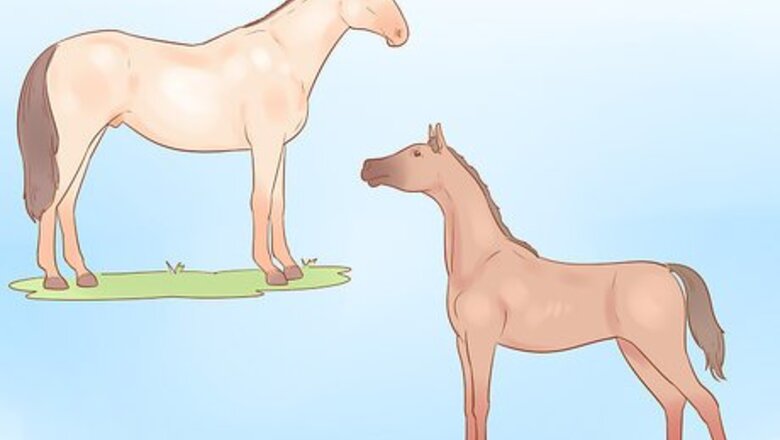
views
Evaluating the Horse's Balance
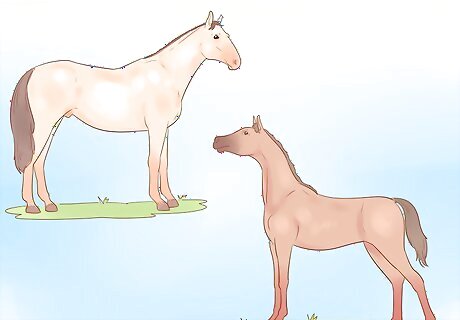
Learn about special considerations for the breeds you judge. Although there are some similarities among different breeds of horses, each breed has its own ideal qualities. Find out as much as you can about the breed you will be judging to ensure that you know what to look for. You can also check with the horse's breeding association for a judging manual. For example, if you are judging American Quarterhorses, then you would need to note the prominence of the horse's withers. Prominent withers are a sign of a well-balanced American Quarterhorse. If you are looking at Hunter in Hand horses, then a longer, leaner, more angular build would be desirable. The ideal Arabian has a high, arched neck that joins with high withers, and long, sloping shoulders. Morgan horses are known for their high, angular shoulders that blend into a short back and the neck almost looks as though it is on top of the withers, rather than coming out of them.
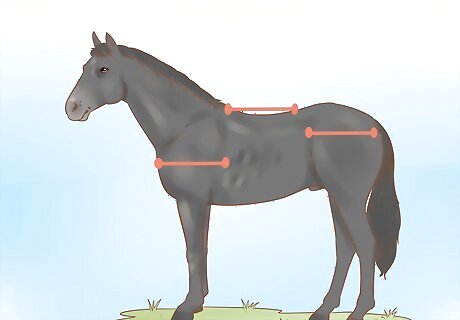
Look for equal lengths of the horse's shoulder, back, and hip. Stand beside the horse about 10 ft (3.0 m) away so that you can see the horse's profile. If these 3 areas appear to be equal in length, then the horse has a balanced conformation. If 1 area is shorter or longer than the rest, then you would deduct points for this imbalance. You can describe the horse's balance conformation by saying something like, “Showed more balance with smooth, symmetrical parts,” or “Lacked overall balance and symmetry of parts.”
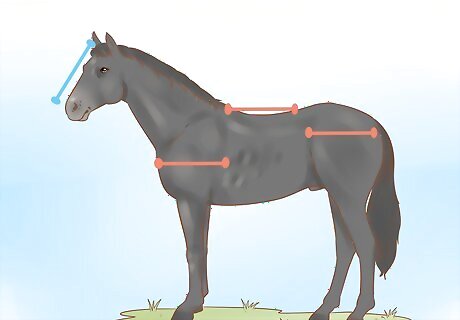
Ensure that the face is no longer than the shoulder, back, and hip. The face starts at the top of the horse's head where it begins to slope downwards and goes to the tip of its nose. Compare the length to the length of the sections of the horse's body you just evaluated. The horse's face should be equal in length to these other sections. If the face appears longer, or shorter than these sections, then the horse is not well-balanced. Note the appearance of the face with something like, “Face in proportion to other parts,” or “Face is out of proportion to other parts.”
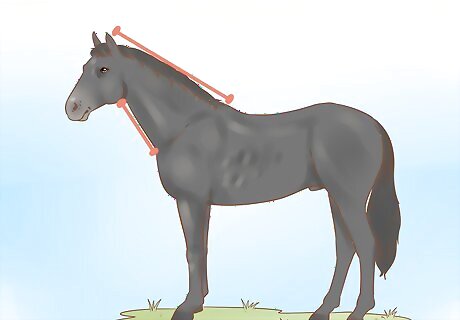
See if the top of the neck is twice as long as the bottom of the neck. Still looking at the horse from the side, compare the top part of its neck to the bottom or underside of its neck. In a well-balanced horse, the top part of the horse's neck should be 2 times the length of the bottom part of the neck. If the top part of the neck is less than 2 times longer than the bottom of the neck, then this would mean the horse is unbalanced. Describe the neck by saying something like, “Longer neck,” or “Shorter neck.”
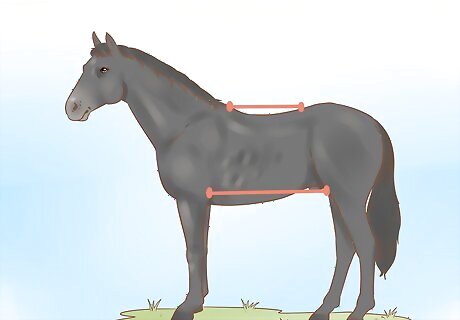
Check to see if the back of the horse is shorter than its underline. Identify the horse's back, which is the section between the withers and flank. Then, look at the horse's underline, which is the section of its stomach between its legs. In a well-balanced horse, the back should be shorter than the underline. If the back is equal to or longer than the underline, the horse is not well-balanced. Describe the back with something like, “Had a longer back in relation to its underline,” or “Had a shorter back in relation to its underline.”
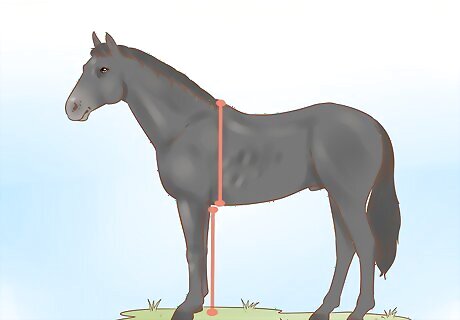
Identify a heart girth equal to the distance to the ground. Still looking at the horse from the side, locate the heart girth. The heart girth begins at the withers and extends straight down to the bottom of the horse's chest. Then, compare this section to the distance from the horse's underline to the ground. The heart girth and the distance from the underline to the ground should be the same. If the heart girth is shorter or longer than the distance to the ground, then the horse is not well-balanced. Describe the heart girth with something like, “Showed greater capacity in heart girth,” or “Lacked capacity in heart girth.”
Checking the Horse's Muscling and Structure
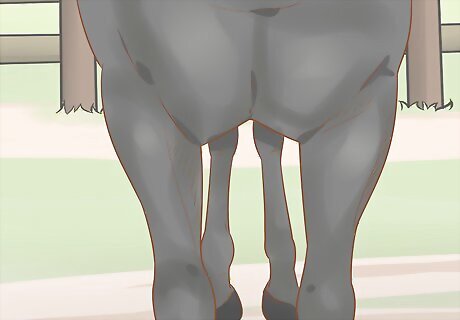
Look for a deep V in between the pectoral muscles. Walk around to the front side of the horse and look at it from about 10 ft (3.0 m) away. Look at the area in the center of the horse's chest and see if there are any visible muscles. You should notice a deep V between the pectoral muscles if the horse is well-muscled. If there is no V or if you cannot see visible muscles, then the horse is not well-muscled. You can use terms like, “Full-chested,” or “flat-chested” to describe the horse's pectorals.

Identify the horse's visible muscles from a side view. Walk around to the side of the horse again, and check for muscling in the horse's shoulder, forearm, loin, and hindquarter. These should be easily visible from a distance of about 10 ft (3.0 m). If you cannot see any muscles from the side, then the horse is not well-muscled. An overall statement on the horse's muscling might be something like, “Showed a greater volume of muscle to frame,” or “Showed a lower volume of muscle to frame.”
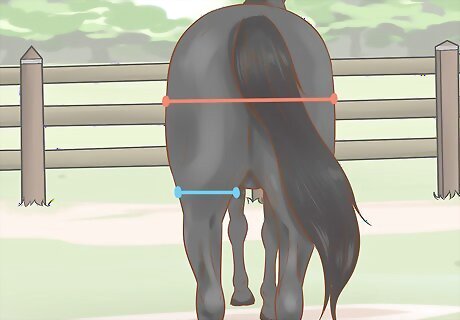
See if the horse's stifle is wider than the hip. The stifle is the width of the horse's buttocks when you view the horse from behind. Stay 10 ft (3.0 m) back from the horse for safety and look at the horse's stifle. Compare the width of the stifle to the hips, which are about 1 ft (0.30 m) above the stifle. The stifle should be noticeably wider than the hips in a well-muscled horse. If the stifle is equal to the hips, then the horse is not well-muscled. You can describe the stifle by adding a statement like, “More muscling at the stifle,” or “Less muscling at the stifle.”
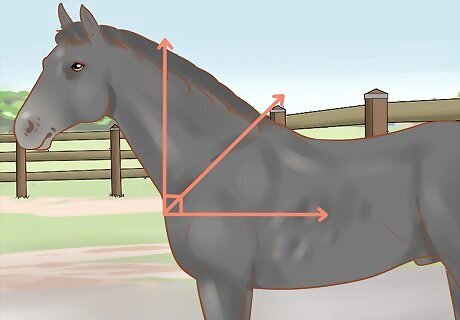
Note the angle of the shoulder and whether it is 45 degrees. A 45 degree angle is desirable in a horse's neck. Walk back around to your position about 10 ft (3.0 m) away from the side of the horse and look at its shoulder from this position. If the angle of the horse's neck is less than a 45 degrees, then its structure is off and this will affect its stride. Try describing the angle of the neck by saying something like, “More correct angle at the neck,” or “Less correct angle at the neck.”

Look for square-shaped hips. Still viewing the horse from the side, look at its hips. The hips should look square. Imagine drawing a square over the horse's hips to help you visualize this. If the hips would not fit within a square, then they are likely rounded, which is not ideal. You can describe the horse's hips by saying something like, “Squarer-placed hips,” or “Rounder-placed hips.
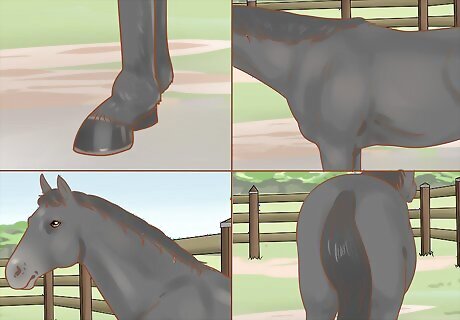
Note the appearance of other parts of the horse for a more in-depth evaluation. How detailed you want to be in your evaluation of a horse depends on the requirements of the association you are judging for and your own preference. Consider if there are other aspects of the horses that you need to factor into your judging, such as: Hoof angles Wither length and prominence Head and neck size Hoof and pastern Top line Legs Back Throat latch Hock placement
Considering the Horse's Action, Quality, and Refinement
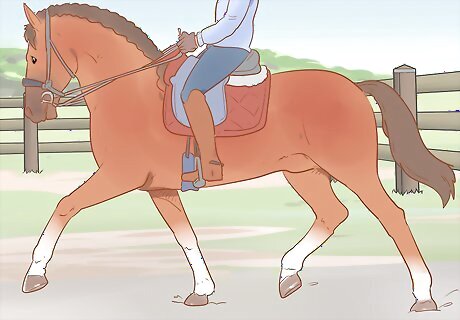
Watch the horse walk to check for a long, straight, and even gait. Be sure to get a look at the horse from the side and back to carefully evaluate the horse's gait. When viewing the horse from the side, the horse should take long strides using the front and back legs equally. When viewing the horse from behind, you should notice that it is moving in a straight line and that it does not deviate to 1 side as it travels. You may also need to watch the horse trot, gallop, or run depending on the breed or competition. Keep in mind that there might be some variation in the ideal stride based on the horse's breed. For example, if you are judging an Arabian, Morgan, or Saddlebred, then more flexion in the hocks and knees is desirable. However, for stock and hunter breeds, less flexion is the norm. Describe the specific features of the horse's gait in your evaluation, such as by saying, “Longer, truer stride” for a horse that takes long strides and moves in a straight line. Or, simply say something like, “Did not travel straight” if the horse deviates to 1 side as it moves.
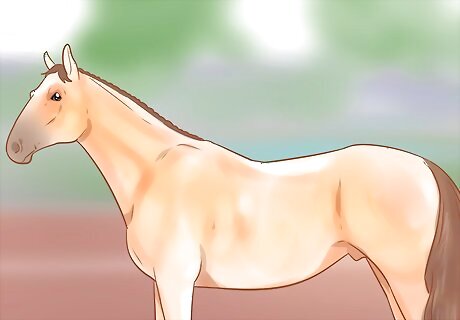
Check the horse's body for a thick, glossy coat. The horse's coat should look shiny and healthy. Walk around the horse to check the coat on all sides, or note the appearance of the coat as you watch it walk. If the horse has any bare or scant patches on its body or if its coat appears dull, then this would be important to note in your evaluation. Describe a horse with a great coat by writing, “Higher quality haircoat,” and describe a horse with a patchy or dull coat by writing, “Lower quality haircoat.”
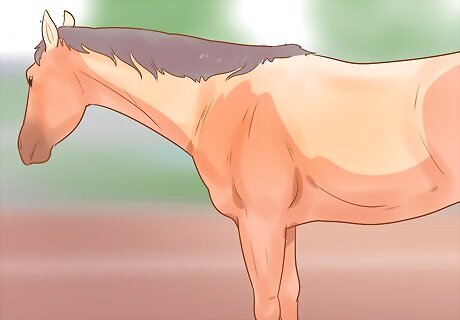
Look for hard, flat bones and a muscular body. Any visible bones or tendons should look hard and flat, and not knotty or fleshy. The horse's body should also have a hard appearance, and there should not be any parts that look fleshy or fatty. A horse that is at a healthy weight will easily meet this criteria, but an overweight horse will likely have some noticeable fatty or fleshy sections. To describe a horse that has a hard, muscular body, you might write, “Showed a greater volume of muscling throughout its body.” Or, to describe a horse with poor muscling and fleshy or fatty spots on a horse, you could write, “Lacked quality to muscle.”
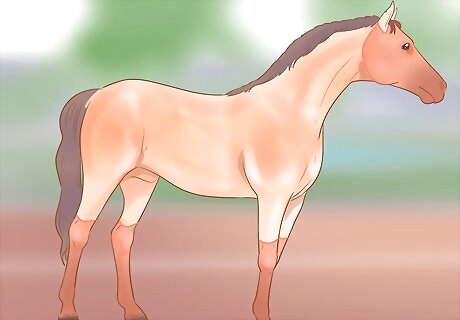
Examine the horse's skin for tightness. Tight skin is desirable in horses, especially in the face, lower legs, and joints. Look at the horse from the front and sides to evaluate its skin for tightness. The skin should be evenly taut all over. If you spot any sections of skin that are sagging or loose, then this would be important to consider in your evaluation. To describe visibly taut skin, write something like, “Noticeably taut skin over the neck and face.” Or, to describe a lack of tightness of skin, you might write something like, “Lacked tautness in neck area.”


















Comments
0 comment